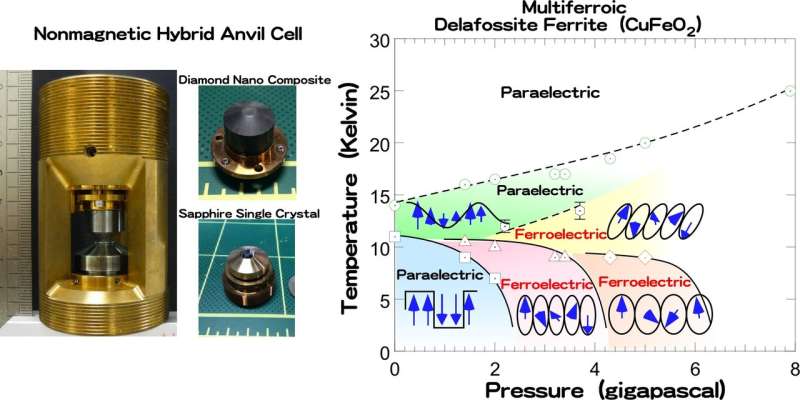Analyzing 3-D neutron polarization under high pressure

A joint research team consisting of NIMS, JAEA and the Institut Laue Langevin has developed a high-pressure cell composed of completely nonmagnetic materials. The team then succeeded for the first time in analyzing neutron polarization in three dimensions at an extremely high pressure of several gigapascals using the cell. This technique is applicable to detailed analysis of electron spin arrangements. The team also discovered a material with potential as a next-generation PC memory material due to the multiferroic properties it exhibited under high pressure. The technique may be used to understand pressure-induced changes in electron spin arrangements in various materials and to develop new materials by controlling spins.
Electron spins fundamentally determine the magnetic properties of materials. Recent research focusing on controlling electron spins has led to the development of new functional materials, including multiferroic materials. The use of neutron diffraction techniques, which enable observation of spin arrangements in materials, is indispensable in these material development efforts. Three-dimensional neutron polarization analysis is particularly effective in determining precise spin arrangements while controlling three-dimensional neutron spin orientations. However, use of this technique requires a cell in which a sample material can be kept in a completely nonmagnetic state in order to preserve the degree of neutron spin polarization specific to the sample. Conventional high-pressure cells are unsuitable for use in this analysis because they are composed of magnetic materials that generate magnetic flux.
In this research, the NIMS-led team developed a completely nonmagnetic high-pressure cell by replacing conventional magnetic cell materials with nonmagnetic composite materials made of diamond particles. The team then confirmed that use of the newly developed cell does not reduce the degree of neutron spin polarization in a sample material. The team also discovered a material that is non-ferroelectric at normal atmospheric pressure in a nonmagnetic environment but becomes ferroelectric and multiferroic when subjected to several tens of thousands of atmospheres of pressure.
The technique developed in this research may be applied to the development not only of multiferroic materials but also of superconducting and other functional materials whose functionalities are closely related to spin arrangements.
More information: Noriki Terada et al, Spherical neutron polarimetry under high pressure for a multiferroic delafossite ferrite, Nature Communications (2018). DOI: 10.1038/s41467-018-06737-6
Journal information: Nature Communications
Provided by National Institute for Materials Science




















